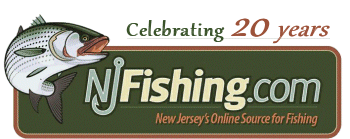 |

|
Message Board
 |

|
 |  | |
 |  | |
 |  | |
 | ||
|
|||||||
| NJFishing.com Fresh Water Fishing Post all your fresh water topics on this board |
 |
|
|
Thread Tools | Display Modes |
|
|
|
#1
|
||||
|
||||
|
I got this from T.U.
NJ Fish and Wildlife is looking for volunteers to assist them with electro fishing the Ken Lockwood Gorge. When: Wednesday July 31st 9:00 am Where: Parking lot – High Bridge side of the Ken Lockwood Gorge I don't understand, if fishing for these trout in July will kill them but electro shocking is okay  I think to look for Young of the Year it has to been done in the summer. I think to look for Young of the Year it has to been done in the summer. |
|
#2
|
||||
|
||||
|
I did a lot of electrofishing when I worked for the DEP up in CT. During August we sampled a lot of streams and rivers and the trout always swam off fine. If you're pulling trout from deep cold water in a lake and releasing them into the warm surface water they can die of temperature shock, this is why people say you shouldn't fish for them in the summer. You don't have to worry about temperature shock in streams and rivers. If you're into trout fishing I would go help out. It's hard work but it's amazing seeing what's swimming around in our waters.
|
|
#3
|
|||
|
|||
|
There is no dangerous build up of lactic acid when you electro fish... Which is part of what kills fish when caught in warmer water temps.
This is a great opportunity to see things you never believed would be in the river... Did it one time on the toms in the tca, I'd highly recommend volunteering if one can.
__________________
-- Rob |
|
#4
|
||||
|
||||
|
You wanna know how many trout are in a stream(or bass in a lake)? Fish it! Sounds pretty easy to me and your not handling them unnecessarily. I never got the whole survey thing myself. Spend enough time fishing somewhere and you'll know what a place holds by what you catch(or don't catch). You can also look in the water and see spawning beds or young fish. Over in Pa, they actually clip the tips of the fins so that when they re-shock(second pass) the stream, they don't count those fin-clipped. Seems pretty harsh to me just for a routine survey. They do grow back but that's beside the point.
__________________
If these heroes - aka criminals - just followed directions and didn’t resist or have an atttude, they’d be alive today. |
|
#5
|
||||
|
||||
|
Quote:
__________________
I ♥ fishing I ♥ New Jersey I ♥ the USA Last edited by acabtp; 07-29-2013 at 11:18 AM.. |
|
#6
|
|||
|
|||
|
Andy and 'acabtp' are both correct on their respective points regarding electro-fishing.
Andy is 100% correct that for the best data regarding the presence of YOY (young-of-year) which is the main criteria used to determine natural reproduction, the best time of year is generally August. There are several reasons for this, among them the water levels are generally low enough to facilitate easier collection, the greatest period of mortality for the young fish has passed (this certainly isn't to say that no more mortality occurs, just that the potential for the greatest percentage of mortality has passed), the biologists have the most available time in their extremely hectic schedules during August, and as an aside it's the least likely time to impact anyone's day astream. As for the many good and valid points that 'acabtp' raises probably the one greatest factor is this..."With electrofishing, you will see, measure and count more or all of those." In addition to being able to count and/or otherwise quantify the total trout population from YOY to the largest specimens in the stream section covered, the biologists also document the presence as well as the abundance and size/year-class structure or all other species present including every caught or observed species of minnow. This additional species data is quite crucial in helping them to determine the overall health of the stream environment. In addition to all the species documentation they also do streamside tests of the water to document the temp, dissolved oxygen level, Ph level, turbidity, etc. Here again these factors all contribute to the statistical picture of the overall health of the stream. Often they will also do some seining for macro-invertebrates (aquatic and semi-aquatic insects, etc) to further complete the stream health picture since these creatures not only provide critical food sources for the fish, they also are good indicators of the overall long-term water quality rather than the 'snapshot' data the biologists acquire from their immediate testing. Hopefully this will help some folks understand the importance of the electro-fishing and all the other data collection that accompanies it. As well I hope it provides a bit better understanding of just some of the extensive and on-going work our freshwater fisheries biologists do both on our behalf as the anglers of NJ as well as for the benefit of freshwater environments we all enjoy so much. |
 |
|
|